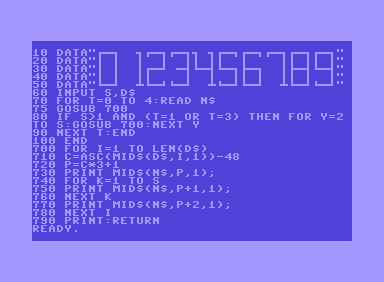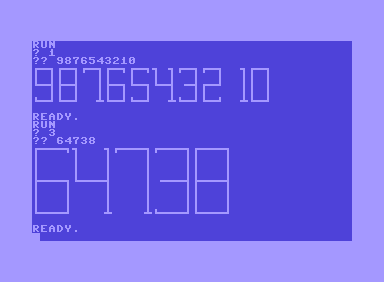C (561 492 bytes)
Author is frmar. He sent me his answer last week (he has not yet created his account).
492 bytes but a bit more obfuscated:
#include<stdio.h>
#include<ctype.h>
#include<stdlib.h>
#define C(x) ((_[*n-'0'])>>s)&m&x
#define P putchar
unsigned _[]={476,144,372,436,184,428,492,148,508,188};
void p(int a,char*n,unsigned m,int s)
{for(;isdigit(*n);++n){P(C(1)?'|':' ');
for(int i=0;i<a;++i)P(C(4)?'_':' ');
P(C(2)?'|':' ');}
P('\n');}
void l(int a,char*b){p(a,b,7,0);int i=1;
for(;i<a;++i)p(a,b,3,3);p(a,b,7,3);i=1;
for(;i<a;++i)p(a,b,3,6);p(a,b,7,6);}
int main(int c,char**v){l(c>1?atoi(v[1]):1,c>2?v[2]:"0123456789");}
Previous version using 561 bytes:
#include<stdio.h>
#include<ctype.h>
#define C(x) ((((*n-'0')[_])>>s)&m&x)
const unsigned _[]={476,144,372,436,184,428,492,148,508,188};
void p(int a,const char*n,unsigned m,int s)
{
for(;isdigit(*n);++n) {
putchar(C(1)?'|':' ');
const char c=C(4)?'_':' ';
for(int i=0;i<a;++i) putchar(c);
putchar(C(2)?'|':' ');
}
putchar('\n');
}
void l(int a,const char*b)
{
p(a,b,7,0);
for(int i=1;i<a;++i)p(a,b,3,3);p(a,b,7,3);
for(int i=1;i<a;++i)p(a,b,3,6);p(a,b,7,6);
}
#include<stdlib.h>
int main(int c,char**v){l(c>1?atoi(v[1]):1,c>2?v[2]:"0123456789");}
Original version from frmar (623 bytes):
#include<stdio.h>
#include<ctype.h>
const unsigned int _[]={476,144,372,436,184,428,492,148,508,188};
void p(int a,const char*n,unsigned int m,int s)
{
for(;isdigit(*n);++n) {
#define C(x) ((((*n-'0')[_])>>s)&m&x)
putchar(C(1)?'|':' ');
const char c=C(4)?'_':' ';
for(int i=0;i<a;++i) putchar(c);
putchar(C(2)?'|':' ');
}
putchar('\n');
}
void print_as_led(int a,const char*b)
{
p(a,b,7,0);
for(int i=1;i<a;++i)p(a,b,3,3);p(a,b,7,3);
for(int i=1;i<a;++i)p(a,b,3,6);p(a,b,7,6);
}
#include<stdlib.h>
int main(int argc,char**argv){print_as_led(argc>1?atoi(argv[1]):1,argc>2?argv[2]:"0123456789");}
Compilation:
$ gcc -std=c99 -Wall print_as_led.c
Examples using default 0123456789 number but different sizes:
$ ./a.out
_ _ _ _ _ _ _ _
| | | _| _||_||_ |_ ||_||_|
|_| ||_ _| | _||_| ||_| |
$ ./a.out 2
__ __ __ __ __ __ __ __
| | | | || || | || || |
| | | __| __||__||__ |__ ||__||__|
| | || | | || | || | |
|__| ||__ __| | __||__| ||__| |
$ ./a.out 3
___ ___ ___ ___ ___ ___ ___ ___
| | | | || || | || || |
| | | | || || | || || |
| | | ___| ___||___||___ |___ ||___||___|
| | || | | || | || | |
| | || | | || | || | |
|___| ||___ ___| | ___||___| ||___| |
Other examples:
$ ./a.out 1 42
_
|_| _|
||_
$ ./a.out 2 42
__
| | |
|__| __|
||
||__
$ ./a.out 3 42
___
| | |
| | |
|___| ___|
||
||
||___
Larger sizes:
$ ./a.out 4 42
____
| | |
| | |
| | |
|____| ____|
||
||
||
||____
$ ./a.out 5 42
_____
| | |
| | |
| | |
| | |
|_____| _____|
||
||
||
||
||_____




2
Some related questions, for code stealing/inspiration: "Emulate a 7-segment display" and "LED Numbers and Letters".
– Darren Stone – 2014-01-23T08:20:03.767@Wasi Thanks. I saw your edit which cleared it up for me. – C0deH4cker – 2014-01-23T10:34:31.770
Your 9 should have the underscore in the last line, to be like reversed 6. – Tomas – 2014-01-27T14:44:33.523
1@Tomas Thanks for the suggestion. But, we already have 13 answers so it will be unfair to change it further :-) – Wasi – 2014-01-27T17:23:47.270
OK Wasi but I hope you don't mind that I used my prefered shape of
– Tomas – 2014-01-27T17:26:45.6909in my answer, as I like it more :-)@Tomas You should post a correct answer first. After that you can append your preferred solution with it if you like. – Wasi – 2014-01-27T17:59:00.330
OK. Don't like it but at least I saved one character on this change :) – Tomas – 2014-01-27T18:04:56.460
Is it allowed to input the zoom number in command line option? – Tomas – 2014-01-27T18:09:38.050
Even more closely related – Peter Taylor – 2014-12-09T19:00:12.363